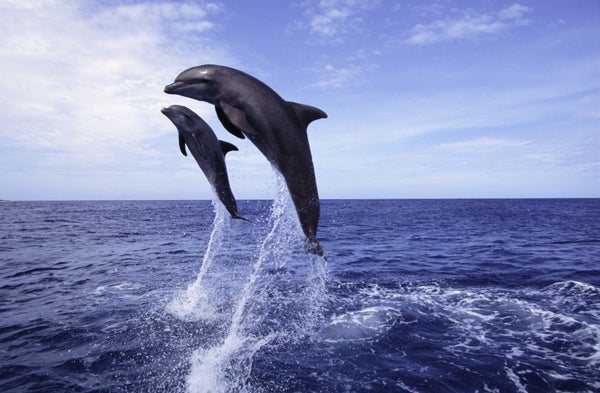Sometimes a snout full of snot can be just what the doctor ordered. At least if you’re a dolphin. Because a new study shows that a little bit of mucus helps these marine mammals generate the rapid-fire stream of clicks they emit and use for echolocation.
First off, let’s just get this out of the way. Dolphins do not actually sound like this. [Flipper laugh sound] That’s a made-for-TV giggle that some say is actually the doctored call of a bird: the Australian kookaburra.
Real dolphins, like these bottlenoses, sound more like this. [Bottlenose sounds] They use their clicks, chirps and whistles to navigate, communicate and to catch their next meal. The high-frequency clicks, in particular, help Flipper and his kind locate and track fish dinners.
On supporting science journalism
If you're enjoying this article, consider supporting our award-winning journalism by subscribing. By purchasing a subscription you are helping to ensure the future of impactful stories about the discoveries and ideas shaping our world today.
Dolphins make these sounds by forcing air through a nasal passage just beneath the blowhole. In this nasal region are liplike flaps of tissue called dorsal bursae that vibrate and collide to produce dolphin talk.
Now, a team of researchers has created a simplified model that can reproduce this characteristic dolphin chatter. And they found that the secret ingredient is snot.
While looking through the literature, oceanographer Aaron Thode stumbled across a model that represented vocal cords as masses connected by springs—which store and release energy—and dampers, which dissipate that energy. This model successfully replicated the essential characteristics of the system, like the frequency of vocal cord vibration.
So Thode enlisted his father Lester, a retired nuclear physicist from Los Alamos National Lab, to help him fit the model to a dolphin’s nasal anatomy. When the Thodes compared the simulated sounds produced by their model to a recording of actual dolphins, they found that the model mimicked both the loud thump and extended ring that are part of the natural click.
The initial thud comes from when those dorsal bursae collide. And the reverberation results from the vibrations that linger when the tissues pull apart. But Thode the younger says the bursae have to be somewhat sticky for the clapping together and snapping apart to produce a noise with the correct loudness and pitch. That stickiness comes courtesy of the mucus. Thode vocalized the results at the meeting of the Acoustical Society in Salt Lake City. [There must be mucus: Using a lumped-parameter model to simulate the "thump" and "ring" of a bottlenose dolphin echolocation click, Presentation 2pABa3, http://acousticalsociety.org/content/spring-2016-meeting]
The match between the simulated sounds and the real deal is encouraging, and the Thodes plan to keep up their collaboration to refine their model. “Yeah, I guess some fathers and sons bond over football, but my dad and I, I guess we bonded over differential equations and writing this paper.”
—Karen Hopkin
[The above text is a transcript of this podcast.)

